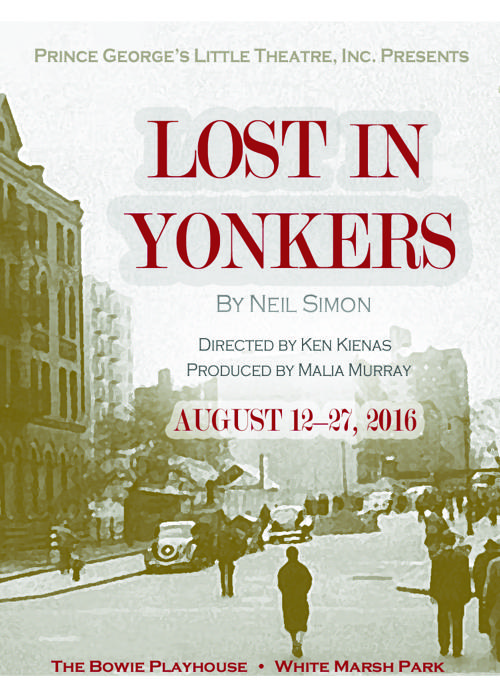The only place in the world where you can truly feel safe is with family. Especially when your family puts the ‘fun’ in dysfunctional as the Kurnitz family does in the classic Neil Simon, Lost in Yonkers, now appearing at Bowie’s playhouse in the woods to start off the 2016/2017 season for Prince George’s Little Theatre. Directed by Ken Kienas, this touching family dramedy tugs at the heartstrings as two teenage boys find themselves unexpected living with their extremely rigid and strictly traditional German grandmother out in Yonkers, New York after the passing of their mother. With radiant heart, a team of seven performers— under Kienas’ keen direction— deliver this tale with striking emotional clarity, balancing the ups and downs of family life against the more humorous moments Simon has brilliantly threaded into the play.
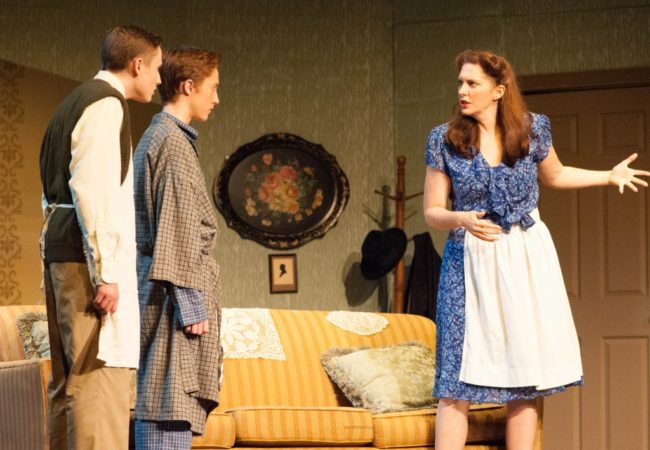
A 1940’s over-shop apartment is Simon’s setting, and Set Designer Dan Lavanga— in conjunction with Set Decorator and Painter Roy Peterson— craft a comfortable niche that represents the epitome of such a picturesque location with their design work. The layered wallpaper, the simple but tasteful furnishings to establish the middle class survival status of the family’s finances, all of these nuanced details give the set of Grandma Kurnitz’ apartment a believable verve which helps to ground the play in its locational reality. Lavanga makes the set complex with his architectural layout, adding depth and dimension to the sprawling apartment.
Costume Designer Jeane Binney perfectly situates the show’s threads in the early 1940’s fashion era, particularly when it comes to the costumes featured on Jay and Arty. While their father and Uncle Louie’s suits are dapper, it’s the bobbed boy pants with high socks on Arty that really draws the audience into the reality of the timing of the play. Binney also does an impressive job with fitting dresses to Bella’s unique personality. In addition to staying within the realm of period appropriate, Binney’s selection for Bella is quirky and off-color, which is displayed in a vivacious and colorful array of patterns, and this suits her unusual personality quirks quite soundly.
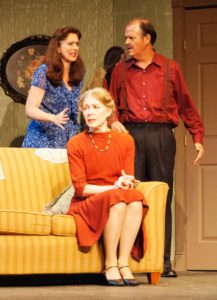
Lighting effects for plays who are set solely inside of a building often go neglected and unnoticed. Lighting Designer Garrett Hyde does an exceptional job of creating ‘natural lighting’ inside the apartment as it streams through the window that faces the street. There is something strikingly authentic about the way his sunlight pours into the space that allows the audience to be swept away into the play’s reality. In addition to this clever use of light, Hyde plays well with darkness for the scenes that take place after hours in the apartment, particularly the initial arrival of Uncle Louie. This focus on light and darkness creates a polished finish for the production on the whole.
Finding the perfect balance between drama and comedy in Neil Simon’s work is no easy task, but it is a task that Director Ken Kienas rises to with great aplomb. The pacing is perfect, with nary a moment’s delay between scenic shifts (which are augmented by Sound Designer Eric Small’s selection of swanky 40’s tunes) and no stalls in active scenes. Kienas also encourages strong accents across the board. Jay and Arty, with the former being the bold leader of the two, have thick Bronx-inspired accents that sound perfect for their upbringing, while Uncle Louie adapts the more traditional Brooklyn gangster sound to his voice. Grandma Kurnitz has a thick German accent but it does not impede the clarity of her speech nor her delivery, both of which are impeccable. In addition to cultivating the natural sound of the dialogue, Kienas nurtures emotional honesty among the performers, resulting in some truly striking moments that squeeze the heart.
Though she has a moment’s cameo, Gert (Jeanne Louise) takes up all the noticeable air in the room for her scene. With an easily over-the-top affectation of her breathing condition, Louise manages to garner the attention of the audience quite quickly during the dinner scene. Playing this tick for sincerity, despite the audiences’ initial reaction of laughter, Louise draws forth a great deal of sympathy for her character, simply by breathing on stage. There is a shared notion among the seven performers— including Eddie (Steve Feder) whose words are more often heard than his face is seen— that their characters are defined by their quirks and unusual behaviors. This concept keeps the play rolling forward swiftly so as to keep the audience fully engaged.
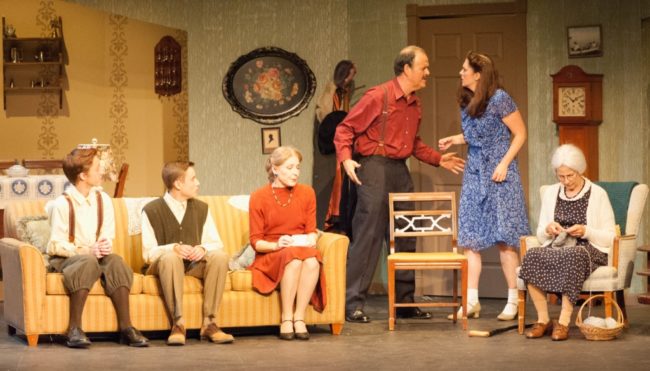
A steel blast of chutzpah, Louie (Brian Binney) is channeling James Cagney straight into the living room upon his arrival. Binney looks sharp, acts sharper, and is a wildly animated animal when it comes to his more emotional charged moments. Between his reactive facial expressions— especially when he’s silently observing a scene (which is rare so enjoy it when it happens)— and his uncontrollable body language, there is something intensely spastic about his performance that draws the eye. Bursting with rage and a whole plethora of other explosive emotions, Binney is the perfect fit for the henchman character.
Bella (Mary Rogers) is a ditzy dollop of a doodle that is an easy mark for poking fun. Rogers creates an impressive dynamic depth to the character of Bella by giving her multiple layers of humanity in addition to her silly surface demeanor. Investing fully with physical ticks, like twisting her skirt or cardigan when she’s nervous, Rogers unearths rich moments of the character’s heart when she interacts with Jay and Arty, as well as her heartbreaking interactions with Grandma Kurnitz. Scenes late in the second act are driven by Rogers with intense heart; these emotionally driven moments between her and Grandma Kurnitz (Leah Mazade) are brutal and delivered in earnest with visceral emotional waves that wash over the audience in a heavy fashion.
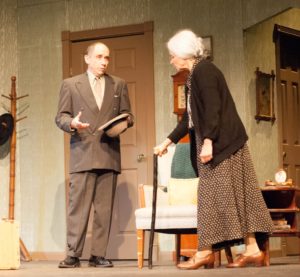
Leah Mazade is a force to be reckoned with on the stage, playing second only to her character’s two grandson’s Jay (Jeremy Crawford) and Arty (Andrew Sharpe.) With a pinched demeanor, a stalwart disposition, and a stiff physicality, Mazade delivers a powerful portrayal of the frozen steel grandmother figure. Her physical approach to the character is astonishing, between the profoundly agitated limp juxtaposed against her upright posture and the way she leans heavy on her cane, Mazade knows how to blend the two realities of her character— mentally strong and physically weak— into one seamless amalgamation of intensity. There is an unwavering emotional wall that Mazade puts into place when it comes to the way Grandma Kurnitz responds to other characters and this is both harrowing and fantastical to observe. A great deal of the show’s humor arrives from the sharply tongued delivery coming from Mazade, her exacting sense of timing aiding tremendously in that arena.
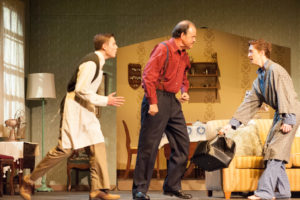
Crawford and Sharpe are talented young performers who easily give Mazade a run for her money on stage. Sharpe relies heavily on the physicality of his character, particularly his facial expressions and subtle gestures, to relay humorous moments to the audience. Watch closely for scenes with his handkerchief and the scene with the soup for some of the most uproariously ticklish moments played out across his face. Crawford carries the story’s narrative on his shoulders. Despite it being the family’s tale, it’s Crawford’s interactions with each character that draws the eye. With a flawless accent that remains consistently throughout the performance and a natural ability to shift the emotional weight of a situation from one extreme to another, Crawford has a working knowledge of how the story unfolds. Both young performers are exceptionally well suited for these roles and their interactions with Mazade bring the show together for one glorious evening of theatre.
This show serves as a brilliant kick-starter to what promises to be a sensational season, if the opening play is any indication. Lost in Yonkers is the perfect heart-warming and touching comedic drama to end the summer, a remarkably polished and professional feeling piece of work from a dedicated team of community theatre individuals.
Running Time: Approximately 2 hours and 40 minutes with one intermission
Lost in Yonkers plays through August 27, 2016 at Prince George’s Little Theatre in residence at The Bowie Playhouse— 16500 White Marsh Park Drive in Bowie, MD. For tickets call the box office at (301) 937-7458 or purchase them online.

